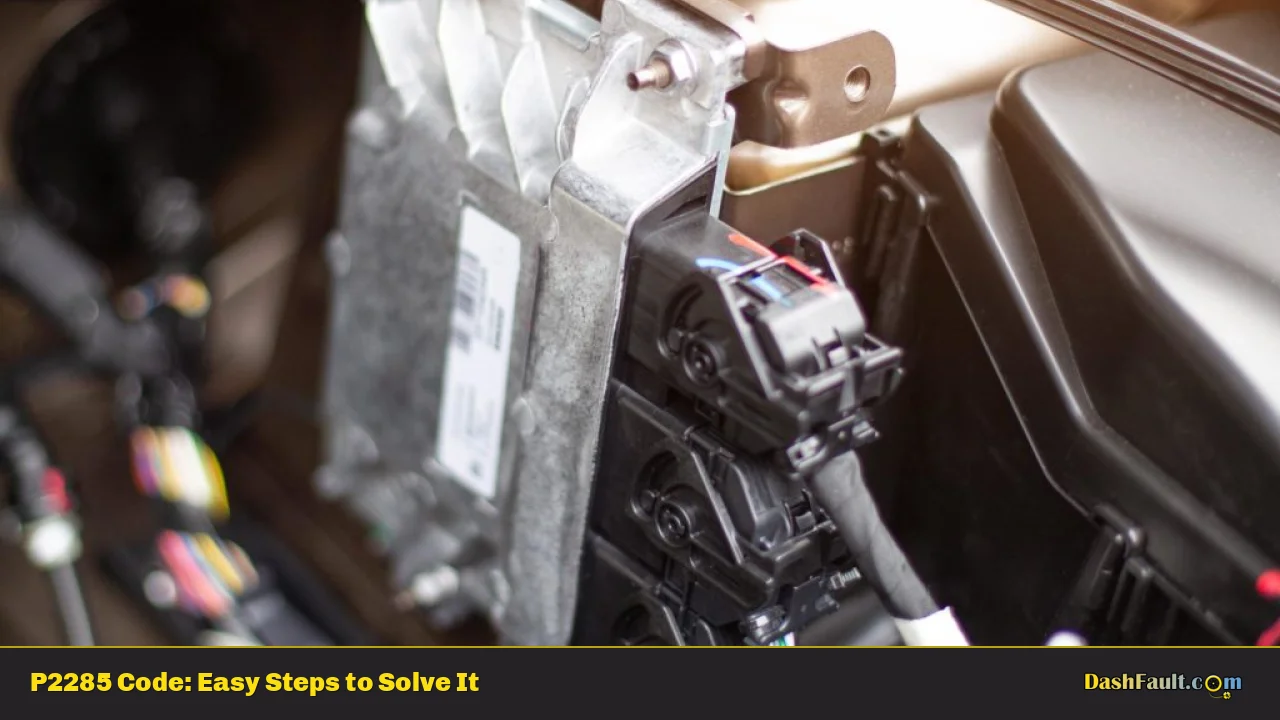The P2285 trouble code is a diagnostic trouble code (DTC) that indicates a problem with the Injector Control Pressure (ICP) sensor circuit. Specifically, it signifies that the Powertrain Control Module (PCM) has detected a voltage or resistance reading that is lower than expected within this circuit. This code is commonly associated with diesel engines, particularly those utilizing a hydraulic electronic unit injector (HEUI) system, where the ICP sensor plays a critical role in regulating fuel injection by monitoring oil pressure.
Understanding this code is essential for vehicle owners and DIY mechanics, as it can lead to significant performance issues if not addressed promptly.
| P2285 Code Meaning | P2285 Code Common Causes |
|---|---|
| Injector Control Pressure Sensor Circuit Low | Low engine oil levels |
| Indicates low voltage or resistance in the ICP sensor circuit | Failed ICP sensor |
| May affect fuel delivery and engine performance | Malfunctioning oil pump |
| Can trigger related codes (P2283, P2284, etc.) | Wiring issues or damaged connectors |
| Defective PCM (Powertrain Control Module) |
Symptoms of the P2285 Code
When the P2285 code is triggered, vehicle owners may notice several symptoms that can indicate underlying issues:
- Check Engine Light: The most immediate sign is the illumination of the check engine light on the dashboard.
- Engine Performance Problems: Drivers may experience rough running, stalling, or difficulty starting the engine.
- Low Oil Pressure: A decrease in oil pressure can occur, impacting overall engine function.
- Failure to Start: In severe cases, the vehicle may not start at all due to compromised fuel delivery.
Technical Explanation of the P2285 Code
The P2285 code is primarily related to the operation of the Injector Control Pressure sensor, which monitors the oil pressure used to control fuel injectors in diesel engines. The ICP sensor provides feedback to the PCM about the oil pressure generated by the high-pressure oil pump. When this feedback indicates a lower-than-normal voltage or resistance, it triggers the P2285 code.
The PCM relies on accurate readings from the ICP sensor to adjust injector timing and ensure proper fuel delivery. If these readings are incorrect, it can lead to inefficient combustion, reduced power output, and potential engine damage if left unresolved.
Step-by-Step Diagnosis of the P2285 Code
Diagnosing a P2285 code involves several steps to identify and rectify the underlying issue:
- Initial Scan: Use an OBD-II scanner to confirm that P2285 is present and check for any related codes (e.g., P2283, P2284).
- Visual Inspection: Inspect wiring and connectors associated with the ICP sensor for signs of damage, corrosion, or loose connections.
- Check Oil Levels: Ensure that engine oil levels are adequate as low oil can affect pressure readings.
- Test ICP Sensor Voltage: Using a multimeter, measure the voltage output from the ICP sensor while the engine is running. Compare this with manufacturer specifications.
- Inspect Oil Pump and IPR: Check for proper operation of the oil pump and Injector Pressure Regulator (IPR), as failures here can also trigger low pressure readings.
- Examine PCM Functionality: If all other components check out, consider testing or replacing the PCM if it’s suspected to be faulty.
Solution Methods for Resolving P2285 Code
Once diagnosed correctly, there are several methods to resolve issues related to the P2285 trouble code:
- Replace Defective Components: If testing reveals a faulty ICP sensor or IPR, replace these components as needed.
- Repair Wiring Issues: Address any damaged wiring or connectors that may be causing intermittent signals.
- Oil System Maintenance: Ensure that oil levels are maintained and consider flushing or replacing old oil if necessary.
- Professional Assistance: If you’re unable to diagnose or resolve the issue effectively, consult with a professional mechanic who can perform advanced diagnostics and repairs.
Repair costs can vary significantly based on vehicle make and model as well as labor rates in your area. Here’s a general breakdown:
- ICP Sensor Replacement: $100 – $300
- Oil Pump Replacement: $300 – $800
- Wiring Repairs: $50 – $200
- Professional Diagnostic Fees: $100 – $200
Always obtain multiple estimates from certified mechanics before proceeding with repairs.
Warnings and Recommendations
When dealing with DTCs like P2285:
- Always refer to your vehicle’s service manual for specific diagnostic procedures related to your make and model.
- Be cautious when working on electrical systems; improper handling can lead to further damage.
- If unsure about any step in diagnosing or repairing your vehicle, seek professional help to avoid costly mistakes.
Frequently Asked Questions About P2285
- What does code P2285 mean?
The P2285 code indicates a low voltage or resistance reading from the Injector Control Pressure sensor circuit. - What are common symptoms of a P2285 code?
Symptoms include an illuminated check engine light, rough engine performance, low oil pressure, and potential failure to start. - Can I drive my vehicle with a P2285 code?
It is not advisable as it can lead to further engine damage; addressing it promptly is recommended. - How do I reset a P2285 code?
You can clear it using an OBD-II scanner after addressing any underlying issues. - What could cause a false P2285 reading?
Poor wiring connections or intermittent faults in sensors can lead to false readings. - Is replacing the ICP sensor always necessary for a P2285 code?
No; thorough diagnostics should confirm whether replacement is needed. - How long does it take to fix a P2285 issue?
The time required varies; simple fixes may take an hour while more complex repairs could take several hours. - Should I consult a mechanic for a P2285 code?
If you’re not experienced with automotive repairs, consulting a mechanic is advisable.
In conclusion, understanding and addressing the P2285 trouble code is crucial for maintaining your vehicle’s performance and longevity. By following systematic diagnostic steps and implementing appropriate solutions, vehicle owners can effectively manage this common issue. Always prioritize safety and seek professional assistance when needed.
